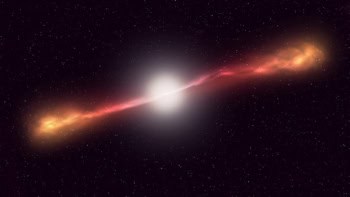Gamma-ray bursts are believed to be the largest explosions in the universe since the big bang. However, detailed observations of the gamma-ray burst GRB 990123 on January 23 - one of the brightest seen to date - suggest that the size of such explosions has been overestimated. For the first time astronomers managed to record an entire gamma-ray burst at a number of optical and gamma wavelengths. The result is a spate of papers published in Science and Nature confirming that the explosion occurred outside our galaxy, and indicating that a jet of radiation headed directly towards Earth (Science March 26, Nature April 1).
Although scientists have known about gamma-ray bursts since 1967, no one has come up with a feasible explanation of why they occur. The explosions may be caused by the collision of super-dense neutron stars; the sudden collapse of a massive star into a black hole; or other, exotic mechanisms. Many astronomers believe that the gamma rays occur when material from an explosion interacts with the interstellar medium. Another problem has been the difficulty in detecting and locating the GRBs. Some bursts last as short as 1 second, while others can last over an hour.
Since 1997 however, an Italian-Dutch X-ray satellite called BeppoSAX has been able to pinpoint the location of the explosions within seconds of their ignition. This information is then passed into a number of instruments on the ground. One such instrument is the Robotic Optical Transient Search Experiment (ROTSE-1) at Los Alamos National Laboratory in the US. ROTSE-1 looks specifically for the optical after-effects of a gamma- ray burst. Carl Akerlof of the University of Michigan and colleagues (Nature 398 400) found that ROTSE-1 saw an optical flare 22 seconds into the start of GRB990123. Over the next few seconds the event increased in optical brightness by a factor of 16 before rapidly declining by a factor of 100 over the next 12 minutes. “If you had been gazing at that spot with binoculars, you would have seen a ‘star’ appear, brighten, and fade within minutes” said Galen Gisler, one of the authors. They suggest that this is evidence that the emission of optical radiation came directly from the explosion.
On January 24, one day after the explosion, Andersen et al. used the Nordic Optical Telescope in the Canary Islands to measure a spectrum of elements that could have been absorbing light from the afterglow (Science 283 2075). This spectrum allowed the authors to calculate the energy and distance of the burst. According to their calculations, which were confirmed by Shri Kulkarni of the Palomar Observatory in California and colleagues (Nature 398 389), the afterglow of GRB990123 had a redshift of 1.6 indicating that it occurred outside our galaxy.
The standard “fireball” model of gamma-ray explosions says that the gamma-rays are produced in an explosion of material that is expanding at near to the speed of light. Using this model Andersen’s group showed that GRB 990123 had 45 times more energy than the total emitted by the most luminous “Type II” supernova – ruling out nearly all the astronomical candidates for gamma-ray explosions that astronomers can think of. According to the authors this suggests that the “fireball” model is incorrect. Instead, they propose that light from the explosion travelled in two jets, one of which pointed towards Earth, a result that would explain why the optical light diminished faster than expected.
Another team led by Alberto Castro-Tirad, also analyzed the optical afterglow of the explosion (Science 283 2069). They also found that after two days, the afterglow decreased rapidly in strength. They suggest that this is what would be expected if a relativistic jet pointing in your direction cooled down and suddenly started to expand sideways, increasing the cooling rate.
Jen Hjorth et. al. meanwhile discovered that light from GRB 990123 was hardly polarized at all – also confirming that the fireball model is incorrect – and indicating the existence of a relativistic jet (Science 283 2073). Finally, Chryssa Kouveliotou of the NASA Marshall Space Flight Center in Huntsville, Alabama, and colleagues (Nature 398 394) traced of the fading afterglow emissions in great detail, including the internal shocks that caused the explosion, the’reverse’ shocks responsible for the prompt optical flash, and the subsequent forward shock that caused the afterglow as the explosion ploughed into the surrounding medium at relativistic speeds.



